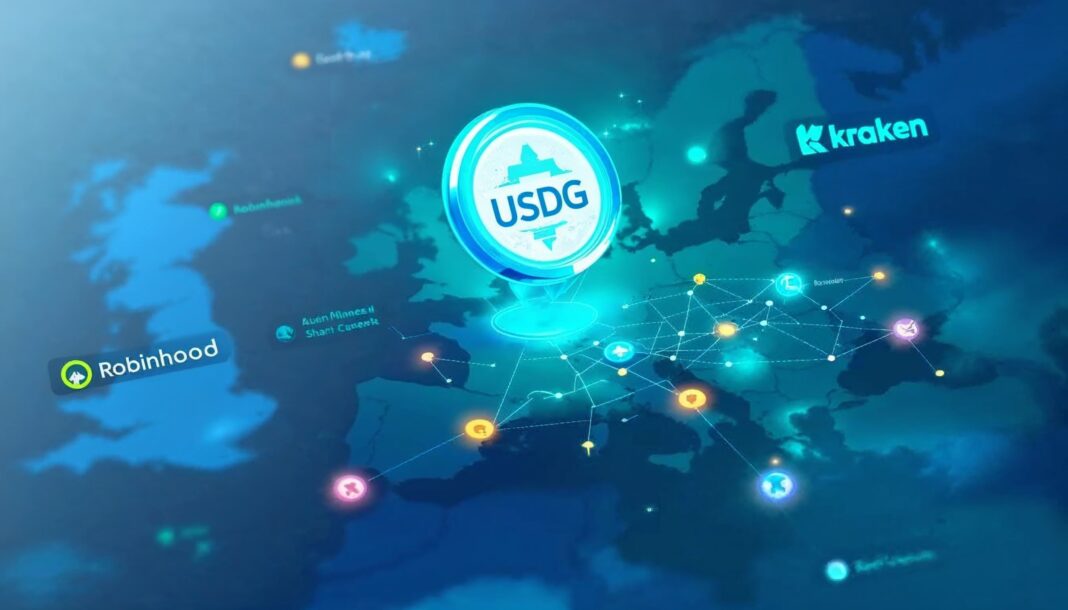Podcast Discussion: Deep Dive Into This Article.
In a major leap forward for the adoption of regulated stablecoins, crypto heavyweights Robinhood and Kraken have officially launched the Global Dollar (USDG) in Europe. The move marks a pivotal moment in the expansion of dollar-backed digital assets beyond U.S. borders, signaling a shift in how everyday users, businesses, and DeFi platforms across the Eurozone may soon interact with crypto and fiat currencies alike.
With USDG now available to European users through the Universal Digital Payments Network (UDPN), the stage is set for a broader transformation of the stablecoin landscape—one that blends fintech usability, institutional credibility, and global interoperability.
What Is USDG and Why Does It Matter?
USDG is a fiat-backed stablecoin pegged 1:1 to the U.S. dollar and governed by the UDPN, a consortium that includes Robinhood, Kraken, Circle, and Revolut, among others. Unlike algorithmic or partially backed stablecoins, USDG is fully collateralized by U.S. dollar reserves and short-term Treasuries, held in regulated financial institutions.
What sets USDG apart is its mission to serve as a global dollar—unconstrained by borders and integrated into both centralized exchanges and decentralized protocols. The stablecoin is designed to be compliant with international regulations, with an emphasis on transparency, AML/KYC procedures, and real-time reserve attestations.
Europe Embraces USDG: A Strategic Entry
Launching in Europe is no coincidence. The region has become a hotbed for digital asset regulation, with the Markets in Crypto-Assets (MiCA) framework offering a harmonized approach across EU member states. USDG’s debut is carefully timed to meet MiCA’s regulatory requirements, positioning it as a compliant, low-friction stablecoin alternative.
With Kraken and Robinhood serving as major on-ramps for retail and institutional crypto investors, the introduction of USDG in Europe provides a robust fiat gateway—one that bypasses the friction of traditional banking systems and accelerates access to DeFi, remittances, and digital payments.
USDG vs USDC, USDT, and Others
While USDC and USDT continue to dominate stablecoin markets, USDG enters the ring with distinct advantages:
- Built-in Exchange Network: As part of the UDPN, USDG comes pre-integrated into leading trading platforms, giving it immediate liquidity and real-world utility.
- Cross-Border Optimization: USDG is being positioned as the first truly “international” stablecoin, optimized for multi-currency conversions and programmable finance through UDPN smart contracts.
- Regulatory Alignment: Unlike Tether, which has long battled transparency concerns, USDG offers a clear regulatory roadmap and undergoes real-time audits through Chainlink’s proof-of-reserve oracle infrastructure.
- Retail and Institutional Crossover: With Robinhood and Kraken at the helm, USDG is uniquely accessible to both everyday traders and larger enterprises, providing dual-track adoption.
DeFi and CBDCs: Bridging the Worlds?
The timing of USDG’s arrival in Europe is particularly relevant as governments across the continent experiment with central bank digital currencies (CBDCs). While CBDCs aim to modernize public sector payments, stablecoins like USDG represent the private sector’s answer to digital cash—programmable, borderless, and available today.
In fact, UDPN is already exploring interoperability between USDG and euro-backed stablecoins, with proposals to allow seamless swapping via zero-knowledge rollups and Layer 2 networks. This could pave the way for a unified digital payments layer—one where stablecoins, CBDCs, and traditional currencies coexist within a user-friendly Web3 experience.
What’s Next?
With USDG now live in Europe, the stablecoin wars are entering a new phase. Robinhood and Kraken are expected to expand USDG’s reach to merchant payment systems, Web3 apps, and DeFi liquidity pools across the continent. There are also whispers of upcoming integrations with traditional fintech apps, including Revolut, N26, and Monzo, which could bring USDG to millions of users overnight.
Meanwhile, UDPN is working behind the scenes to deploy cross-chain support for USDG, allowing it to circulate across Ethereum, Solana, Avalanche, and emerging Layer 2 networks like Base and zkSync.
Conclusion
The launch of USDG in Europe marks a watershed moment for stablecoins. Backed by the trusted names of Robinhood and Kraken, governed by a global payments network, and aligned with upcoming EU regulations, USDG is positioning itself as the stablecoin of choice for the next generation of digital finance.
As the lines between fiat, crypto, and DeFi continue to blur, USDG could become the connective tissue binding them all together. For traders, builders, and investors alike, the message is clear: the Global Dollar is here—and it’s just getting started.
This article reflects the opinions of the publisher based on available information at the time of writing. It is not intended to provide financial advice, and it does not necessarily represent the views of the news site or its affiliates. Readers are encouraged to conduct further research or consult with a financial advisor before making any investment decisions.



